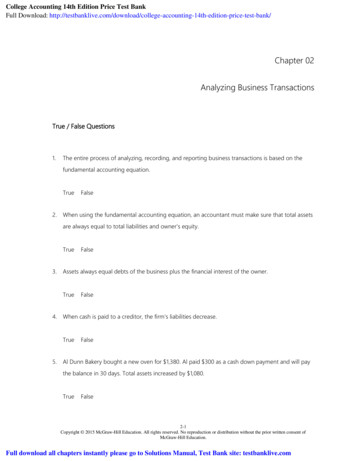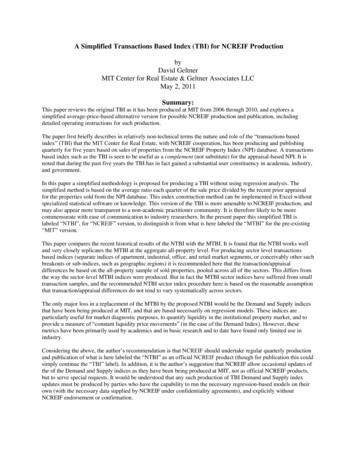
Transcription
A Simplified Transactions Based Index (TBI) for NCREIF ProductionbyDavid GeltnerMIT Center for Real Estate & Geltner Associates LLCMay 2, 2011Summary:This paper reviews the original TBI as it has been produced at MIT from 2006 through 2010, and explores asimplified average-price-based alternative version for possible NCREIF production and publication, includingdetailed operating instructions for such production.The paper first briefly describes in relatively non-technical terms the nature and role of the “transactions basedindex” (TBI) that the MIT Center for Real Estate, with NCREIF cooperation, has been producing and publishingquarterly for five years based on sales of properties from the NCREIF Property Index (NPI) database. A transactionsbased index such as the TBI is seen to be useful as a complement (not substitute) for the appraisal-based NPI. It isnoted that during the past five years the TBI has in fact gained a substantial user constituency in academia, industry,and government.In this paper a simplified methodology is proposed for producing a TBI without using regression analysis. Thesimplified method is based on the average ratio each quarter of the sale price divided by the recent prior appraisalfor the properties sold from the NPI database. This index construction method can be implemented in Excel withoutspecialized statistical software or knowledge. This version of the TBI is more amenable to NCREIF production, andmay also appear more transparent to a non-academic practitioner community. It is therefore likely to be morecommensurate with ease of communication to industry researchers. In the present paper this simplified TBI islabeled “NTBI”, for “NCREIF” version, to distinguish it from what is here labeled the “MTBI” for the pre-existing“MIT” version.This paper compares the recent historical results of the NTBI with the MTBI. It is found that the NTBI works welland very closely replicates the MTBI at the aggregate all-property level. For producing sector level transactionsbased indices (separate indices of apartment, industrial, office, and retail market segments, or conceivably other suchbreakouts or sub-indices, such as geographic regions) it is recommended here that the transaction/appraisaldifferences be based on the all-property sample of sold properties, pooled across all of the sectors. This differs fromthe way the sector-level MTBI indices were produced. But in fact the MTBI sector indices have suffered from smalltransaction samples, and the recommended NTBI sector index procedure here is based on the reasonable assumptionthat transaction/appraisal differences do not tend to vary systematically across sectors.The only major loss in a replacement of the MTBI by the proposed NTBI would be the Demand and Supply indicesthat have been being produced at MIT, and that are based necessarily on regression models. These indices areparticularly useful for market diagnostic purposes, to quantify liquidity in the institutional property market, and toprovide a measure of “constant liquidity price movements” (in the case of the Demand Index). However, thesemetrics have been primarily used by academics and in basic research and to date have found only limited use inindustry.Considering the above, the author’s recommendation is that NCREIF should undertake regular quarterly productionand publication of what is here labeled the “NTBI” as an official NCREIF product (though for publication this couldsimply continue the “TBI” label). In addition, it is the author’s suggestion that NCREIF allow occasional updates ofthe of the Demand and Supply indices as they have been being produced at MIT, not as official NCREIF products,but to serve special requests. It would be understood that any such production of TBI Demand and Supply indexupdates must be produced by parties who have the capability to run the necessary regression-based models on theirown (with the necessary data supplied by NCREIF under confidentiality agreements), and explicitly withoutNCREIF endorsement or confirmation.
Table of Contents:1. Background . Page 12. What is the TBI and Why is it useful? Page 23. How does the TBI work? Page 74. Addressing NCREIF’s requirements for TBI production:A simplified TBI Page 95. Comparison of the NTBI and MTBI . Page 126. Conclusions & recommendations . Page 17Appendix A:Value-weighted &/or NOI-based versionsof the NTBI . Page A-1Appendix B*:Steps in the Operational Productionof the NTBI . Page B-1(*Accompanied by a example Excel templates)
A Simplified Transactions Based Index (TBI) for NCREIF Productionby David Geltner1. Background“In summary, we argue that the NCREIF Index is ready to evolve into two more specializedsuccessor families of index products: one tailored for fundamental asset class research support,and the other tailored for investment performance evaluation benchmarking and performanceattribution.”-- From: D.Geltner & D.Ling, Benchmarks & Index Needs in the U.S. Private Real EstateInvestment Industry: Trying to Close the Gap (A RERI Study for the Pension Real EstateAssociation), October 17, 2000.The National Association of Real Estate Investment Fiduciaries (NCREIF) is a non-profit industryassociation founded in 1982 to serve the institutional real estate investment community as a non-partisancollector, processor, validator and disseminator of real estate performance information. NCREIF’sseminal information product is the NCREIF Property Index (NPI) which publishes quarterly investmentperformance results for properties held on behalf of tax-exempt institutions by NCREIF’s datacontributing members, which represent the majority of all major U.S. pension fund core real estateinvestment holdings. The NPI has become a major reference and benchmark of U.S. real estateinvestment performance and is widely cited and used in both academic and industry research.An issue which has long been raised regarding some types of research is the fact that the NPI is based onappraisals, or estimated valuations of its constituent properties as reported by the data-contributingmembers. The quote at the top of this page is from a 2000 white paper commissioned by PREA whichsuggested that, as valuable and relevant as the NPI is for many important types of analysis and research,the industry could benefit from the development of complementary index products based more directlyand purely on realized transaction prices of properties sold in the marketplace.With this in mind, the MIT Center for Real Estate proposed to NCREIF in 2004, and NCREIFsupported, the development of a “transactions based index” (TBI), based on the actual transaction pricesof the properties sold from the NPI database. Over the course of 2004 and 2005 the TBI was developedat MIT by a team led by David Geltner and Henry Pollakowski at MIT and Jeff Fisher at IndianaUniversity. The TBI methodology and initial index results were presented at several academic andindustry research gatherings during 2005 and 2006, and published in great detail in a 2007 article in oneof the top academic real estate journals (hereinafter referred to as “FGP2007”).1 At its annual fallmeeting in 2005 NCREIF approved the regular on-going quarterly production and publication of the TBIby, and at, the MIT Center for Real Estate, with the proviso that the TBI was not to be labeled oridentified as an official NCREIF product. MIT launched the regular quarterly publication of the TBI inFebruary 2006 with the 4th-quarter 2005 index results (and index history going back to 1984), and MIThas published the TBI every quarter since then (now through 4Q2010).21J.Fisher, D.Geltner, & H.Pollakowski, “A Quarterly Transactions-based Index of Institutional Real Estate InvestmentPerformance and Movements in Supply and Demand”, Journal of Real Estate Finance & Economics (2007) 34:5-33.2The TBI has been published electronically, on the MIT/CRE website at: http://web.mit.edu/cre. Note that, like NCREIF, MIThas always clearly stated that the TBI is not an “MIT product”, and is not to be officially named or labeled as such. The MITPage 1
In the five years since the start of the TBI’s regular publication, the index has gradually gained animportant user constituency. The TBI is frequently cited in academic articles (as of late 2010 theFGP2007 article had 39 citations in Google Scholar3) as well as in industry reports and white papers4.The Federal Reserve Board research staff employs the TBI in their quarterly update to the FOMC, andboth Bloomberg and the Federal Reserve Bank of St.Louis have requested redistribution rights for theTBI.5 Ibbotson Associates regularly provides the TBI by request to selected clients.Purpose of the present report:With the above in mind, NCREIF is presently contemplating taking in-house the production andpublication of the TBI, as a NCREIF product. Correspondingly, MIT is looking forward to transferringmuch or all of the TBI production and publication responsibilities to NCREIF. The purpose of thepresent paper is to present some ideas and considerations to help facilitate this transition. In particular, asimplified version of the TBI will be presented and proposed.2. What is the TBI & Why is it Useful?As it has been produced at MIT, the TBI is a set of related indices all using the same underlyingtransaction price based methodology, as described in the FGP2007 article (available on the MIT/CREwebsite). The TBI is produced at the “All-property” level, which aggregates all NCREIF sold propertiesas if in a single population. The TBI has also been produced separately at the national sector level foreach of the four core commercial property usage type sectors: apartment, industrial, office and retail, ineach case based on independent separate (purely within-sector) populations. For each of these fiveaggregations, the TBI product suite has included four indices: Price change (or capital return), Totalreturn (which includes income), Demand-side reservation price changes (referred to as the “DemandIndex” or “constant liquidity index”), and Supply-side reservation price changes (referred to as the“Supply Index”). Thus, there are in all 20 indices (4 different indices each for the five differentaggregations including the four sectors and the all-property aggregate). Like the NPI, the TBI is aquarterly index, updated at the end of each calendar quarter. The TBI has been considered preliminaryduring the current calendar year until the final end-of-year update after which the index has been“frozen” (not subject to any further changes).6Center for Real Estate has always provided the TBI gratis and pro bono as a service to the academic and industry researchcommunities.3As another indication, this article ranks 9th out of 141 articles published in the JREFE from 2006 through 2008 in thenumber of its subsequent citations (by other articles) within the Social Science Citation Index, the premier index ofacademic journals in the economics and finance field. This is a good measure of the relative influence of an article in theacademic community.4A typical example is: G.MacKinnon, “REITs and Real Estate: Is There Room for Both in a Portfolio”, PREA Research Report,October 2010.5Rights which, through 2010, no one had authority to give.6This “freezing” of the TBI is done for convenience of users, including to give index levels a permanency as referencebenchmarks for historical price levels. It is also done for consistency with the official NPI, which is also frozen. As a practicalmatter, the TBI has generally not experienced significant “backward adjustments”, or changes to its previously estimatedhistory as new sales data is appended to the historical database each quarter. (The TBI is not a “repeat-sales” index, whichis a type of price index construction methodology in which backward adjustments can be more of an issue.)Page 2
To better appreciate what the TBI is and how it is useful in the context of the institutional real estateinvestment industry that NCREIF serves, let us step back and survey broadly the types of indices thatcan be constructed for tracking and quantifying the pricing and investment performance of commercialproperties in the U.S. As suggested in Exhibit 1, at a very broad-brush level one can distinguish twomajor types of investment property asset price and/or return indices: appraisal-based and transactionsbased.7Exhibit 1Typology of Investment Property IndicesAppraisal-based:Transactions-based: Based on regular,consistent appraisals(internal, external subjectiveestimates of values) Census (not sample) oftarget population (universe) Auditable, corresponds tomgr reports to clients Suitable for benchmarking Based directly purely ontransaction prices of soldproperties (objective info, cashchanging hands) Sold properties are a sampleof underlying population Important for research (acad &indust), not suitable forbenchmarkingSynchronous:Rolling: PropsAd hocAll propertiesappraised as of endof each period (IPD)appraised on rollingor staggered basis,some ea period (NPI)StatisticalTwo types are complementary, not substitutes.Transactions-based & Appraisal-based Indices:Appraisal-based indices like the NPI are the original and “classical” type of performance index in theinstitutional real estate investment industry. They are uniquely useful by virtue of providing a completeand auditable “census” of all of the properties in a given specifically identified population of interest(e.g., NCREIF approximates the “universe” of all core properties held by or on behalf of major taxexempt institutions in the U.S., all the data-contributing members of NCREIF). Because of this, andbecause the appraisals on which such indices are based correspond closely to how net asset value and7This ignores other types that are less relevant in the present context, such as REIT-based indices, and survey-based“notional” indices based on brokers’ opinions. The description of “Appraisal-based” indices in Exhibit 1 has in mind inparticular the rigorous, auditable investment performance benchmarking oriented indices compiled from exhaustive sets ofproperty investment database-contributing members’ valuation reports, such as that of NCREIF and the InvestmentProperty Databank (IPD). Other types of what might be termed “expert estimation-based” indices are also possible, such asGreen Street’s recent “GSA-CPPI”, but may differ in important ways from the traditional appraisal-based indices consideredhere.Page 3
investment performance is officially reported by funds and investment managers to their investors andclients, appraisal-based indices are most appropriate as benchmarks for gauging and understandinginvestment management performance, and for tracking at a broad level the fundamental propertyvaluations underlying the official “book value” or “carried value” of the institutional investor clients ofsuch investment managers.However, appraisal-based indices tend to exhibit what researchers refer to as “smoothing” or “lag bias”.By necessity and norms of practice, the property-level appraisal process that underlies appraisal-basedindices tends to be more conservative about recognizing value changes, and more “backward-looking”for price discovery and documentation, than are the principal parties engaging in actual transactions.Also, in some cases the appraisals (or valuation reports) used in the index are effectively not updated forall properties as of the end of each period (i.e., the appraisals in the index are staggered or rolling intime). The overall result is that appraisal-based indices tend to exhibit dampened market cycle amplitudeand/or lagged turning points in the cycle, as well as lower return volatility, compared to transactionsbased indices. This smoothing and lagging bias can be problematical for certain types of investmentindustry research, including market tracking, trading strategies, portfolio analyses, and comparisonsacross major investment asset classes (such as real estate, equities, and fixed income).8There are also some important populations of commercial investment properties that are not regularlyappraised (e.g., the broad population of all U.S. institutional commercial property, beyond just that heldby NCREIF members, including properties held by REITs and properties collateralizing CMBS). Forsuch properties, appraisal-based indices are not possible, but transactions-based indices can and areproduced.9 Therefore, for apples-to-apples comparisons between NCREIF property performance andsuch broader populations, a transactions-based index for NCREIF properties is useful in principle.Transactions-based indices, if well constructed, can address many of the above-noted issues concerningappraisal-based indices, and provide a different perspective more directly reflecting movements in thepricing within the asset marketplace. Transactions based indices thereby can provide a very useful andinteresting complement to (but not substitute for) appraisal-based indices, in the context of NCREIF’smission. Transactions-based indices by definition are based directly and purely on actuallyconsummated property asset sale transactions. Apart from possible reporting or recording errors, theyare thus based on completely objective price information, rather than the more subjective and judgmentbased valuation estimates that underlie appraisal-based indices. Methodologically, transactions-basedindices are in principle completely replicable. Transactions based indices have the theoretical virtue ofbeing based on the actual timing and amount of cash changing hands in the free market, thereby obeying8For example, appraisal-based smoothing and lagging have the effect in classical mean-variance optimized portfolioallocation research of making the role of the private real estate asset class appear greater than it actually is in comparisonwith the other asset classes that do not suffer from appraisal smoothing effects, such as stocks and bonds. This undercutsthe usefulness of appraisal-based real estate indices in mixed-asset investment analysis research and can undercut thecredibility of real estate as a core institutional asset class. Technically, the problem is that the smoothing and lagging biastends to reduce real estate’s apparent volatility and covariance with the other asset classes.9The initial example is the Moody’s/REAL Commercial Property Price Index (CPPI), a repeat-sales index based on the RealCapital Analytics Inc database of property sales over 2,500,000, based on methodology developed at the MIT Center forReal Estate, produced and published monthly since December 2006. A similar more recent such index is the CoStarCommercial Repeat-Sales Index (CCRSI), produced and published monthly by CoStar Group since August 2010.Page 4
the classical dictum: “follow the cash.”10 Transactions prices, in contrast to appraisal-based valuations,directly reflect the current equilibrium, such as it may be, between buyers and sellers in the asset marketat any given time. All of the above gives transactions-based indices a certain type of credibility andmeaningfulness both among academic economists and among many practitioners and policy makers.Such credible price tracking information can be useful for the real estate investment industry, helping toraise the credibility and depth of understanding of the industry among a broader constituency.Transactions based indices are also a useful practical tool in conjunction with appraisal based indices, asthe transactions based indices tend to temporally lead the appraisal indices in the major price movementsor turning points. Transactions based indices therefore tend to be more predictive, and they reduce thesmoothing and lagging bias problem noted previously.Types of Transactions-based Indices: Ad hoc vs Statistical With this in mind, let us continue our overview of index typology, now focusing within the world oftransactions-based indices. Here one can distinguish two major approaches to transactions-based indexconstruction, as indicated in Exhibit 2 (on the next page). Ad hoc price indices are based on simpleaverage price metrics, without use of econometric optimization techniques or explicit control fordifferences among the properties transacting in one period compared to the next. Ad hoc transactionprice based indices have been around for a long time in the housing industry, such as the NationalAssociation of Realtors Median Home Price Index. Similar such indices in commercial real estate tendto be more recent and not as high profile or not regularly published, but are available from sources suchas Real Capital Analytics and CoStar (among others). But ad hoc price indices have more seriousproblems for commercial real estate than for housing, because of the much greater degree ofheterogeneity across individual properties in the commercial market. This leads to a major apples-vsoranges problem in comparing the average prices of properties sold one period with the average pricesof properties sold the next period. If, for example, the average price per square-foot increases from oneperiod to the next, to what extent is that due to an actual increase in same-property (or “same-store”)asset prices, or rather to some sort of “flight to quality” in which a larger proportion of “premium” assetswere sold during the second period? Such ad hoc indices also do not take advantage of the capabilitiesof modern statistics and computational power to minimize error or noise in the price indices.1110Good transactions-based indices, like the TBI, strive to filter out from the index database deals that are not “arms length”,whose prices do not reflect free market exchange.11A major attempt to produce what would here be classified as an ad hoc transaction price based index of commercialproperty occurred in 2007 with the launch by Standard & Poor’s of their S&P/GRA Commercial Real Estate Index availablefor trading on the CME (ticker: SPCREX). This was a type of average price per square foot index that attempted to controlfor differences in property types trading from one period to the next, but in an ad hoc manner without use of formalregression models. The index folded at the end of 2008 after it failed to register a significant decline in prices during themarket collapse of that year, and with no trading of the index taking place. A more recent index which is a bit hard toclassify is the Green Street Commercial Property Price Index (GSA-CPPI, launched in 2009), which is based on Green Street’svalue estimates of REIT-held properties (used to construct Green Street’s REIT NAV estimates). As the author understandsthis index, though Green Street states that transactions are considered in the GSA-CPPI’s computation, the GSA-CPPIattempts to represent a leading indicator of property price trends by including information gleaned from brokers andinformation about deals in the negotiation phase in addition to closed transactions. The exact index constructionmethodology is not clear, and it is not clear to what extent formal econometric models are employed. The GSA-CPPI isinteresting, but seems to be clearly (and perhaps purposely) a subjective measure, at least in part, and in that sense moreakin to an appraisal-based index than a pure transactions-based index, though a very different type of “appraisal” processthan what underlies the NPI.Page 5
Exhibit 2Typology of Transactions-based IndicesStatistical:Ad Hoc: Controlled for differences intraded properties betweenperiods. “Optimized” according toeconometric principles(minimize error)Repeat-SalesRegression(same-property) Not controlled fordifferences in tradedproperties betw periods. Not “optimized” according toeconometric )Median Price/SFMean Price/SFAny of these may be either equal-wtd or value-wtd across observations:(Equal-wtd generally superior from a statistical perspective.)For these reasons, most academics, and more recently some of the more sophisticated industryresearchers, advocate statistically rigorous, econometrically-based transactions price indices. Suchindices make use of statistical regression to estimate the changes in market prices from one period to thenext, with more explicit and effective controls for differences in the type and quality of propertiestransacting in different periods. On the other hand, ad hoc indices can sometimes have an advantageover statistical indices in that many industry practitioners lack familiarity or comfort with regressionmodels of property prices. The ad hoc indices may appear more transparent or easy to understandwithout specialized expertise, in some cases.12The TBI as it has been produced at MIT represents an econometrically rigorous statistical index, basedon all, and only, the properties sold each quarter from the NCREIF population of properties (that is, theproperties included within the NPI). As will be presented later in Section 4, this paper will propose asimplified version of the TBI that might be classified as an ad hoc index by the criteria described in thissection. However, it will be shown that the proposed simplified methodology replicates extremelyclosely the econometrically based TBI that has been being produced at MIT. Indeed, the simplified TBImethodology proposed in this paper attempts to have “the best of both worlds”, by taking advantage ofNCREIF’s unique data advantages to produce an index that essentially reflects the rigor and purity of a12This is not necessarily always true, particular if one delves into the details of index production, and in any case may be aproblem more of communication about index methodology than an inherent or irreducible problem of the indexmethodology itself. It is also the type of problem that tends to go away over time, as the industry gradually learns about thetransactions based indices, which are a relatively new type of information product in commercial real estate.Page 6
statistical transactions based index while retaining the transparency and intuitive appeal of a simple adhoc type index, as we shall see in the next section.3. How does the TBI work?In this section we will review the way the TBI has been being produced at MIT so as to facilitate theunderstanding of, and transition to, the simplified TBI production method being proposed in this paper.As produced at MIT, the TBI is based on a statistical regression model of the transaction prices of theNCREIF sold properties. This is known in the academic literature as a “hedonic” price model. It will beuseful to understand something about this methodology even if NCREIF will use a differentmethodology going forward, as the TBI to date has been based on this price model and the proposedsimplified TBI in fact tracks the regression-based index extremely closely.A hedonic price index controls for the differences between properties transacting in consecutive periodsof time by the use of “hedonic variables” in a regression model of property transaction prices. Thehedonic variables describe the essential price-determining characteristics of each property. In classicalacademic hedonic price models the explanatory variables typically include parameters such as the size,age, and location (e.g., neighborhood, or distance from CBD, or from airport, etc) of the property. Theregression’s estimated coefficients on the hedonic variables control for cross-sectional differenceswhich could affect prices among the properties in the transaction sample. If the hedonic variables are alltemporal constants (i.e., they don’t vary across time within a given property, e.g., property size), then theprice model will also include time dummy variables (i.e., set equal to one for the period when theproperty transacts, zero otherwise). The coefficients on these time-dummy variables will then reflect thelongitudinal (i.e., across time) differences in prices, and it is these longitudinal differences that matterfor constructing the price index.If some of the hedonic variables also vary across time (e.g., property age, or more to the point:property’s current appraised value), then the price index must be constructed by defining a“representative property” whose hedonic characteristics are used in the right-hand side of the equation.The price index is then defined by the changes in the model’s predicted price for the representativeproperty each period. To reflect “same-property” (or “same-store”) asset price changes in the index suchas investors actually face, it is necessary to somehow reflect in the hedonic variables the aging of theproperties from one period to the next, so that the representative property reflected in the index agesone-for-one with the passage of calendar time (this of course is the case in property appraisals as theyare updated for the same building over time).A data challenge in constructing a hedonic transactions-based index is that it requires good andconsistent hedonic data on all the properties in the transaction sample, for all of the important hedonicvariables. This is often problematical for commercial property in the U.S. Another (related) problem isthe issue of defining an appropriate “specification” of the model, that is, which hedonic variables to use,and how to use them (e.g., what functional form, for example, shall one consider building age as a linearvariable in years, or a quadratic variable in years and years-squared, or what?.) These challenges oftenmake it difficult to construct useful hedonic price indices of commercial property, particularly from apractical perspective for industry usage as opposed to purely academic study.Page 7
The TBI’s Advantage as a Hedonic Price Index:Fortunately, the NCREIF Index database provides a unique way to get around this data limitation,because the properties in the NPI are all subject to fre
In this paper a simplified methodology is proposed for producing a TBI without using regression analysis. The simplified method is based on the average ratio each quarter of the sale price divided by the recent prior appraisal for the properties sold from the NPI database. This index construction method can be implemented in Excel without
